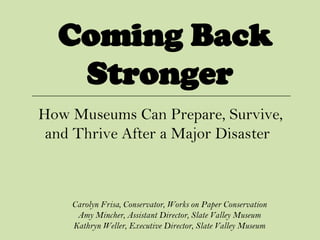
How Museums Can Prepare, Survive and Thrive After a Major Disaster
- 1. Coming Back Stronger How Museums Can Prepare, Survive, and Thrive After a Major Disaster Carolyn Frisa, Conservator, Works on Paper Conservation Amy Mincher, Assistant Director, Slate Valley Museum Kathryn Weller, Executive Director, Slate Valley Museum
- 2. The Story of the Slate Valley Museum Kate— Show video--can incorporate it into slide if it is a youtube? (or transfer to PowerPoint and insert video) 10-15 minutes about SVM
- 3. Activity Can you name the two most vulnerable items? What are your priorities? What items are most valuable?
- 4. Before the Disaster • Use Google Drive for disaster related documents • Invite your conservator to the museum • Politicians • Build relationships before a disaster happens • Insurance Company o Know your policy • Be able to update your website from home
- 5. Emergency Plan Options • D-Plan • Pocket Response • Create Your Own • Create a “Disaster Kit” aka “React Packs” • Review your plan • Do it once as a trial • Consult fire and police in your town before Plan has to be implemented • Make sure people on your contact list know that they are in your disaster plan
- 6. Emergency Plan • Map of collections • In your plan, make sure you have names and phone numbers of tour companies, state transportation agencies • In your plan, make sure that phone numbers are organized well
- 7. Using the Emergency Plan Volunteers • first removed artifacts, exhibits, and furniture to assess damage • cleaned floors • assessed, inventoried, and photographed damaged materials Toxicity and environmental issues: Protect yourself and your volunteers
- 8. Activity Who would you call first? Make a map of your collection
- 9. Activity • Insurance policies—do you qualify for FEMA, are you insured, what is your deductible
- 11. The Story of Plymouth Notch Insert image of RT 100a Contact motor coach companies to reschedule Contact officials to find out the condition of the roads What happens when the community is impacted—how can the museum be used as a community space?